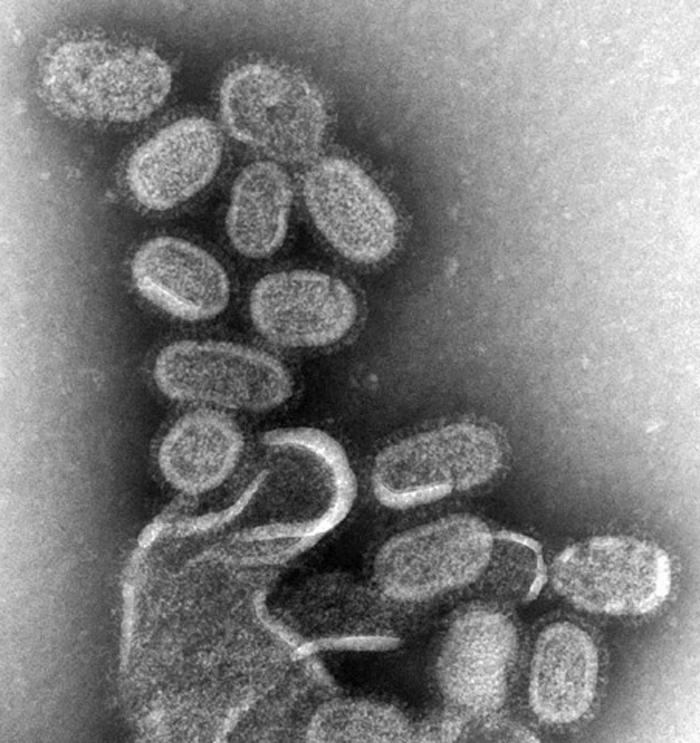Influenza: Difference between revisions
| Line 40: | Line 40: | ||
==[[Influenza future or investigational therapies|Future or Investigational Therapies]]== | ==[[Influenza future or investigational therapies|Future or Investigational Therapies]]== | ||
== | ==[[Influenza causes|Causes of Influenza]]== | ||
Influenza | |||
==[[Influenza cost-effectiveness of therapy|Cost-Effectiveness of Therapy]]== | ==[[Influenza cost-effectiveness of therapy|Cost-Effectiveness of Therapy]]== | ||
Revision as of 22:38, 9 January 2012
|
Influenza Microchapters |
|
Diagnosis |
|---|
|
Treatment |
|
Case Studies |
|
Influenza On the Web |
|
American Roentgen Ray Society Images of Influenza |
For patient information click here
| Influenza | |
 | |
|---|---|
| TEM of negatively stained influenza virons, magnified approximately 70,000 times | |
| ICD-10 | J10, J11 |
| ICD-9 | 487 |
| DiseasesDB | 6791 |
| MedlinePlus | 000080 |
| MeSH | D007251 |
Editor-In-Chief: C. Michael Gibson, M.S., M.D. [1]
Overview
Historical perspective
Classification
Diagnosis
History & Symptoms
Lab Tests
Epidemiology & Demographics
Primary Prevention
Medical Therapy
Future or Investigational Therapies
Causes of Influenza
Cost-Effectiveness of Therapy
See also
- Information concerning flu research can be found at
References and notes
Further reading
- NEJM's Avian Influenza
- Bernd Sebastian Kamps, Christian Hoffmann and Wolfgang Preiser (Eds.) Influenza Report 2006 Flying publisher 2006.
- Arnold J. Levine 'Viruses' Scientific American Library, WH Freeman, 1992 ISBN 0-7167-5031-7
- Samuel Baron et al. 'Medical Microbiology' Fourth Edition, The University of Texas Medical Branch at Galveston 1996 ISBN 0-9631172-1-1.
- Cox NJ, Subbarao K. 'Influenza.' Lancet. 1999 Oct 9;354(9186):1277–82. PMID 10520648
- Edwin D. Kilbourne Influenza Pandemics of the 20th Century Emerging Infectious Diseases Special Issue: Influenza Vol. 12, No. 1 January 2006
- Richard Collier 'The Plague of the Spanish Lady' Macmillan publishers (London) 1974 ISBN 0-7490-0246-8
- John M. Barry 'The Great Influenza: the Epic Story of the Deadliest Plague in History' Penguin 2004 ISBN 0-670-89473-7
- Webster RG, Bean WJ, Gorman OT, Chambers TM, Kawaoka Y. "Evolution and ecology of influenza A viruses." Microbiol Rev. 1992 Mar;56(1):152–79. PMID 1579108
- Scholtissek C. 'Molecular epidemiology of influenza.' Arch Virol Suppl. 1997;13:99–103. PMID 9413530
- Adolfo García-Sastre Antiviral Response in Pandemic Influenza Viruses 'Emerging Infectious Diseases Special Issue: Influenza Vol. 12, No. 1 January 2006
- Zambon MC. 'The pathogenesis of influenza in humans.' Rev Med Virol. 2001 Jul–Aug;11(4):227–41. PMID 11479929
- Walter R. Dowdle Influenza Pandemic Periodicity, Virus Recycling, and the Art of Risk Assessment 'Emerging Infectious Diseases Special Issue: Influenza Vol. 12, No. 1 January 2006
- Horimoto T, Kawaoka Y. Pandemic threat posed by avian influenza A viruses. Clin Microbiol Rev. 2001 Jan;14(1):129–49. PMID 11148006
- Epidemiology of WHO-confirmed human cases of avian influenza A(H5N1) infection
- CDC 2005. Centers for Disease Control. Prevention and Control of Influenza Recommendations of the Advisory Committee on Immunization Practices (ACIP). MMWR 2005; 54 (RR08): 1–40.
- Arnold S. Monto Vaccines and Antiviral Drugs in Pandemic Preparedness Emerging Infectious Diseases Special Issue: Influenza Vol. 12, No. 1 January 2006
- Peter Palese Making Better Influenza Virus Vaccines? Emerging Infectious Diseases Special Issue: Influenza Vol. 12, No. 1 January 2006
- WHO (PDF} contains latest Evolutionary "Tree of Life" for H5N1 article Antigenic and genetic characteristics of H5N1 viruses and candidate H5N1 vaccine viruses developed for potential use as pre-pandemic vaccines published August 18, 2006
- WHO's assessment of Flu Research as of November 2006.
External links
- Info on influenza at CDC
- Fact Sheet Overview of influenza at World Health Organization
- Health encyclopedia entry at NHS Direct
- BioHealthBase Bioinformatics Resource Center Database of influenza sequences and related information.
- Overview of influenza at MedicineNet
- Congressional Research Service (CRS) Reports regarding Influenza Law related government reports at University of North Texas
- Influenza Surveillance and Contingency Plans (by Country/Region)
- Orthomyxoviridae The Universal Virus Database of the International Committee on Taxonomy of Viruses
- Influenza Virus Resource from the NCBI
- InfluenzaWorld Resource for all influenza-related information.
|
Influenza Microchapters |
|
Diagnosis |
|---|
|
Treatment |
|
Case Studies |
|
Influenza On the Web |
|
American Roentgen Ray Society Images of Influenza |
Template:Respiratory pathology Template:Viral diseases Template:Link FA
ar:فيروس إنفلونزا bg:Грип ca:Grip cs:Chřipka cy:Y ffliw da:Influenza de:Influenza el:Γρίπη eo:Gripo eu:Gripe fa:آنفلوآنزا fi:Influenssa gl:Gripe he:שפעת hr:Gripa id:Influensa io:Influenzo it:Influenza kk:Тұмау ko:인플루엔자 lv:gripa hu:Influenza nl:Griep nn:Influensa no:Influensa simple:Influenza sk:Chrípka sl:Gripa sr:Грип sq:Gripi sv:Influensa th:ไข้หวัดใหญ่ wa:Virûsse del gripe yi:פלו zh-min-nan:Liû-hêng-sèng kám-mō͘